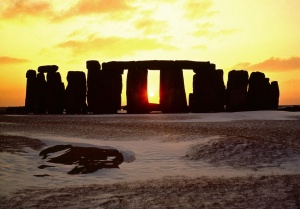Winter Solstice: Difference between revisions
Pablo Sender (talk | contribs) (Created page with "{{Template:Article needs expansion}} <br> <br> <br> ==Online resources== ===Articles=== *[http://www.theosociety.org/pasadena/sunrise/43-93-4/xt-haman.htm# Winter Solstice — Gi...") |
No edit summary |
||
| Line 1: | Line 1: | ||
[[File:Stonehenge at winter solstice.jpg|right|300px|thumb|Winter soltice sunset at Stonehenge]] | |||
< | ''' Winter Soltice''' is a celestial occurrence of great significance in most religions and cultures. It is recognized as the day with the shortest period of daylight and longest night of the year. The Sun appears at its lowest elevation, because the Earth's North pole has reached its maximum tilt away from the star. In modern times the event generally falls on December 21 or 22. | ||
< | |||
< | == Theosophical viewpoints == | ||
==Online resources== | |||
===Articles=== | Several [[Theosophy|Theosophists]] have commented on the winter solstice. | ||
*[http://www.theosociety.org/pasadena/sunrise/43-93-4/xt-haman.htm# Winter Solstice — Gift of Illumination] by Dorothea Hamann | |||
*[http://www.theosociety.org/pasadena/sunrise/49-99-0/4s-aed.htm# Christmas and the Winter Solstice] by Alan E. Donant | [[Helena Petrovna Blavatsky|H. P. Blavatsky]] wrote: | ||
<blockquote> | |||
[[Christmas]] comes just at the time of the winter solstice; the days then are shortest, and [[Darkness]] is more upon the face of the earth than ever. All the sun-gods were believed to be annually born at that epoch; for from this time its Light dispels more and more darkness with each succeeding day, and the power of the Sun begins to increase.<ref>Helena Petrovna Blavatsky, ''Collected Writings'' vol. II (Wheaton, IL: Theosophical Publishing House, [1967]), 164.</ref> | |||
</blockquote> | |||
<blockquote> | |||
We are in the [[Winter Solstice]], the period at which the Sun entering the sign of Capricornus has already, since December 21st, ceased to advance in the Southern Hemisphere, and, cancer or crablike, begins to move back. It is at this particular time that, every year, he is born, and December 25th was the day of the birth of the Sun for those who inhabited the Northern Hemisphere. It is also on December the 25th, Christmas, the day with the Christians on which the “Saviour of the World” was born, that were born, ages before him, the Persian Mithra, the Egyptian [[Osiris]], the Greek Bacchus, the Phoenician Adonis, the Phrygian Attis. And, while at Memphis the people were shown the image of the god Day, taken out of his cradle, the Romans marked December 25th in their calendar as the day natalis solis invicti.<ref>Helena Petrovna Blavatsky, ''Collected Writings'' vol. X (Wheaton, IL: Theosophical Publishing House, 1988), 278-279.</ref> | |||
</blockquote> | |||
== Neolithic people == | |||
People of the Neolithic period constructed '''Stonehenge''' on the Salisbury Plain of England between 3000 BCE and 2000 BCE. It is a ring of standing stones topped with lintels, with trilithons and other structures of massive size that serve as an astronomical calculator. At dawn of the Summer Solstice and sunset of the Winter Solstice, sunlight shines between the stones | |||
== Online resources == | |||
=== Articles === | |||
* [http://www.theosociety.org/pasadena/sunrise/43-93-4/xt-haman.htm# Winter Solstice — Gift of Illumination] by Dorothea Hamann. | |||
* [http://www.theosociety.org/pasadena/sunrise/49-99-0/4s-aed.htm# Christmas and the Winter Solstice] by Alan E. Donant | |||
* [https://www.theosociety.org/pasadena/sunrise/40-90-1/oc-ebt.htm Sacred Solstice] by Elsa-Brita Titchenell. | |||
* [https://www.english-heritage.org.uk/visit/places/stonehenge/things-to-do/solstice/what-is-the-winter-solstice/ Winter Solstice and Stonehenge] at English Heritage website. | |||
===Books=== | ===Books=== | ||
*[http://www.theosociety.org/pasadena/4sacsea/4sacsea1.htm# ''The Four Sacred Seasons'' Ch 1., "The Winter Solstice"] by G. de Purucker | *[http://www.theosociety.org/pasadena/4sacsea/4sacsea1.htm# ''The Four Sacred Seasons'' Ch 1., "The Winter Solstice"] by G. de Purucker | ||
Revision as of 21:02, 30 November 2021
Winter Soltice is a celestial occurrence of great significance in most religions and cultures. It is recognized as the day with the shortest period of daylight and longest night of the year. The Sun appears at its lowest elevation, because the Earth's North pole has reached its maximum tilt away from the star. In modern times the event generally falls on December 21 or 22.
Theosophical viewpoints
Several Theosophists have commented on the winter solstice.
H. P. Blavatsky wrote:
Christmas comes just at the time of the winter solstice; the days then are shortest, and Darkness is more upon the face of the earth than ever. All the sun-gods were believed to be annually born at that epoch; for from this time its Light dispels more and more darkness with each succeeding day, and the power of the Sun begins to increase.[1]
We are in the Winter Solstice, the period at which the Sun entering the sign of Capricornus has already, since December 21st, ceased to advance in the Southern Hemisphere, and, cancer or crablike, begins to move back. It is at this particular time that, every year, he is born, and December 25th was the day of the birth of the Sun for those who inhabited the Northern Hemisphere. It is also on December the 25th, Christmas, the day with the Christians on which the “Saviour of the World” was born, that were born, ages before him, the Persian Mithra, the Egyptian Osiris, the Greek Bacchus, the Phoenician Adonis, the Phrygian Attis. And, while at Memphis the people were shown the image of the god Day, taken out of his cradle, the Romans marked December 25th in their calendar as the day natalis solis invicti.[2]
Neolithic people
People of the Neolithic period constructed Stonehenge on the Salisbury Plain of England between 3000 BCE and 2000 BCE. It is a ring of standing stones topped with lintels, with trilithons and other structures of massive size that serve as an astronomical calculator. At dawn of the Summer Solstice and sunset of the Winter Solstice, sunlight shines between the stones
Online resources
Articles
- Winter Solstice — Gift of Illumination by Dorothea Hamann.
- Christmas and the Winter Solstice by Alan E. Donant
- Sacred Solstice by Elsa-Brita Titchenell.
- Winter Solstice and Stonehenge at English Heritage website.
Books
- The Four Sacred Seasons Ch 1., "The Winter Solstice" by G. de Purucker
